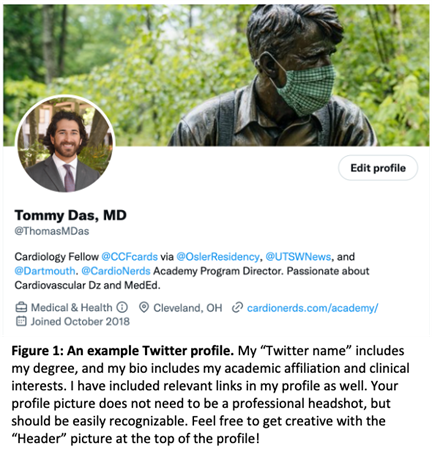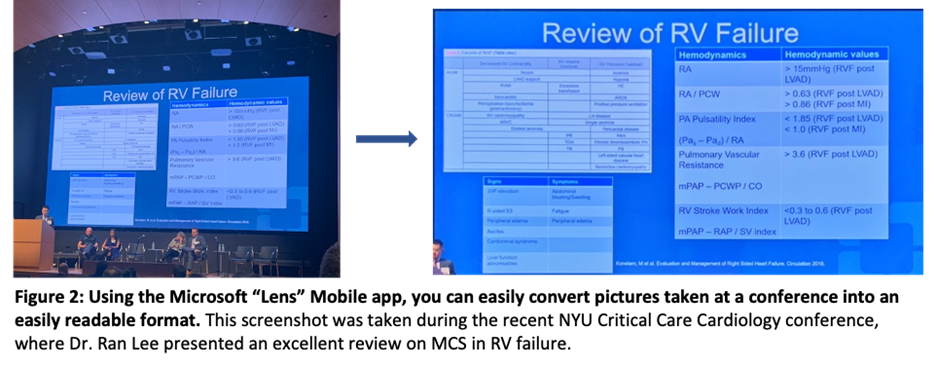Tips and Tricks For Making the Most of Twitter at Conferences
Social media platforms, including Twitter, have become widely adopted across the cardiology community. This is particularly relevant during conferences, as most societies have embraced Twitter to supplement their meetings. Whether you are attending a conference to present research, grow your body of knowledge, or network with your community, a thoughtful Twitter presence can greatly amplify your experience. Below are tips for attendees to consider before, during, and after their next conference.
Before the conference

Before attending the conference, spend time ensuring your Twitter bio is up to date. While there is no required format, consider including your clinical specialty, academic affiliation, and your interests (professional or otherwise) (Figure 1). You can also change which tweet is "pinned" to the top of your profile, increasing the visibility of a tweet that is specifically relevant to the conference. Finally, if you're dusting off a previously dormant profile, review your posting history and ensure there is nothing embarrassing you'd like to delete. Remember that your Twitter profile serves as an introduction to those you meet at the conference; make sure the impression it leaves is a positive one!
During the conference
Once you arrive at the conference, Twitter can both supplement your learning and increase the visibility of your presentations. Posting content from a session you're currently attending, also known as "live tweeting," is a common way to use Twitter to engage with conference content. One strategy for live tweeting is to photograph an ongoing presentation and post the picture along with your thoughts (ensure this type of sharing is permissible under the conference rules). When crafting your tweet, include the Twitter profile of the speaker as well as the conference hashtag; this allows others to easily find your content and amplify its reach through "liking" and "re-tweeting". Another tip is to use the "Microsoft Lens" mobile application, which can automatically crop and align photos of projected slides into an easily readable format (Figure 2). The appeal of live tweeting is the potential for sparking a conversation, both among those attending the conference in person and those following along from home. Consider tagging experts relevant to the material in your posts, though be cognizant of not over-tagging so as not to overwhelm others with notifications. One potential pitfall is allowing your engagement with social media to supersede the conference itself; one can spend an entire plenary session crafting the perfect tweet on their phone while missing the actual content being presented. When live tweeting, I prefer to take pictures while listening to the session, then post a tweet after the session is over. This allows me to focus on the presentation in the moment, while also affording plenty of time to consider how I'd like to phrase a tweet after the fact.

If you are attending the conference as a presenter, you may also find Twitter useful in sharing your science. I recommend including your Twitter handle on poster(s) and slides, as this helps your audience quickly find your profile and connect with your community . For those presenting posters, consider taking a picture of yourself in front of your poster and tweeting as the session starts to help draw attention to your board; make sure to tag collaborators and mentors specific to your project as well. For faculty attending a conference, posting about your mentee's presentation can also be incredibly impactful in promoting their work and raising their profile amongst the community.
Finally, remember that one of the biggest draws of any conference is the community; this is an opportunity to meet and reconnect with others in your field. If everyone in the picture is on board, posting a group selfie on Twitter can be a fun way to commemorate the occasion and lean into the "social" nature of social media!
After the Conference
While you may be waiting to catch your flight back home, that doesn't mean the benefits of the conference are at an end! After the conference is over, spend some time looking through tweets using the conference hashtag. Sometimes a conversation that started during the conference could still be ongoing, as others following remotely add their opinion and continue the dialogue. If there was a speaker whose work you found particularly compelling, consider messaging them directly to start a conversation. While this may be intimidating, you never know when this networking could lead to your next collaboration!
A final word of caution: remember that Twitter is a tool that can supplement a conference, and not the point of the conference itself. Additionally, everyone has their own priorities when attending a meeting, whether it be updating themselves on the latest science in the field, presenting their own original research, or simply seeing old friends. If Twitter is helping you in your personal conference goals, that in of itself has value. Happy tweeting!
This article was written by Thomas Das, MD, a FIT at Cleveland Clinic. Twitter: @ThomasMDas. Special thanks to Amit Goyal, MD, FACC; Devesh Rai, MD; and Pooja Prasad, MD, for their insights which helped inform this article.
This content was developed independently from the content developed for ACC.org. This content was not reviewed by the American College of Cardiology (ACC) for medical accuracy and the content is provided on an "as is" basis. Inclusion on ACC.org does not constitute a guarantee or endorsement by the ACC and ACC makes no warranty that the content is accurate, complete or error-free. The content is not a substitute for personalized medical advice and is not intended to be used as the sole basis for making individualized medical or health-related decisions. Statements or opinions expressed in this content reflect the views of the authors and do not reflect the official policy of ACC.
